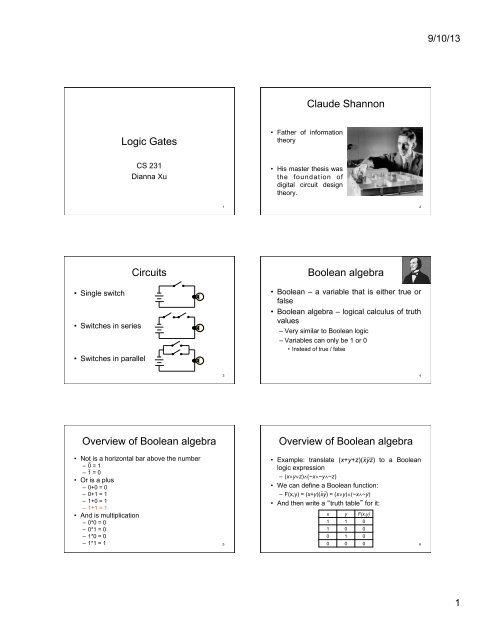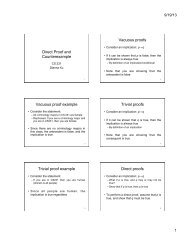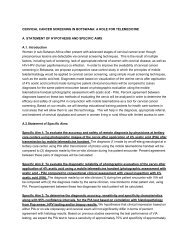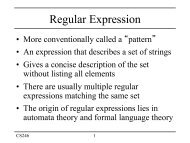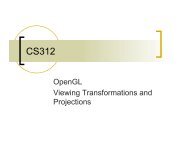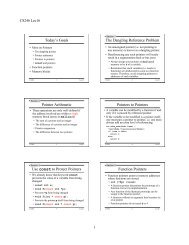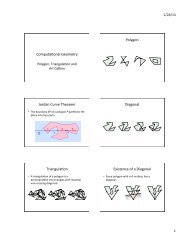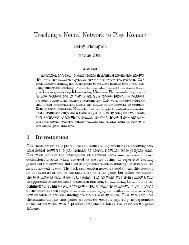Logic Gates Claude Shannon Circuits Boolean algebra Overview of ...
Logic Gates Claude Shannon Circuits Boolean algebra Overview of ...
Logic Gates Claude Shannon Circuits Boolean algebra Overview of ...
Create successful ePaper yourself
Turn your PDF publications into a flip-book with our unique Google optimized e-Paper software.
9/10/13<br />
<strong>Claude</strong> <strong>Shannon</strong><br />
<strong>Logic</strong> <strong>Gates</strong><br />
• Father <strong>of</strong> information<br />
theory<br />
CS 231<br />
Dianna Xu<br />
• His master thesis was<br />
the foundation <strong>of</strong><br />
digital circuit design<br />
theory.<br />
1<br />
2<br />
• Single switch<br />
• Switches in series<br />
• Switches in parallel<br />
<strong>Circuits</strong><br />
<strong>Boolean</strong> <strong>algebra</strong><br />
• <strong>Boolean</strong> – a variable that is either true or<br />
false<br />
• <strong>Boolean</strong> <strong>algebra</strong> – logical calculus <strong>of</strong> truth<br />
values<br />
– Very similar to <strong>Boolean</strong> logic<br />
– Variables can only be 1 or 0<br />
• Instead <strong>of</strong> true / false<br />
3<br />
4<br />
<strong>Overview</strong> <strong>of</strong> <strong>Boolean</strong> <strong>algebra</strong><br />
• Not _ is a horizontal bar above the number<br />
– 0 _ = 1<br />
– 1 = 0<br />
• Or is a plus<br />
– 0+0 = 0<br />
– 0+1 = 1<br />
– 1+0 = 1<br />
– 1+1 = 1<br />
• And is multiplication<br />
– 0*0 = 0<br />
– 0*1 = 0<br />
– 1*0 = 0<br />
– 1*1 = 1<br />
5<br />
<strong>Overview</strong> <strong>of</strong> <strong>Boolean</strong> <strong>algebra</strong><br />
_ _ _<br />
• Example: translate (x+y+z)(xyz) to a <strong>Boolean</strong><br />
logic expression<br />
– (x∨y∨z)∧(~x∧~y∧~z)<br />
• We can define a <strong>Boolean</strong> function:<br />
_ _<br />
– F(x,y) = (x+y)(xy) = (x∨y)∧(~x∧~y)<br />
• And then write a “truth table” for it:<br />
x y F(x,y)<br />
1 1 0<br />
1 0 0<br />
0 1 0<br />
0 0 0<br />
6<br />
1
9/10/13<br />
Basic logic gates<br />
Combinational circuit rules<br />
• Not<br />
• And<br />
• Or<br />
• Nand<br />
• Nor<br />
• Xor<br />
x<br />
x<br />
y<br />
x<br />
y<br />
x<br />
y<br />
x<br />
y<br />
x<br />
y<br />
x<br />
xy x y<br />
xyz<br />
x+y<br />
z<br />
x<br />
y<br />
z<br />
x+y+z<br />
xy<br />
x+y<br />
xÅ y<br />
7<br />
• In general, gates can be combined into<br />
combinational circuits<br />
• Rules:<br />
– Never combine two input wires<br />
– A single input wire can be split partway and<br />
used as input for two separate gates<br />
– An output wire can be used as input<br />
– No output <strong>of</strong> a gate can eventually feed back<br />
into that same gate<br />
8<br />
Converting between circuits and<br />
<strong>Boolean</strong> expressions<br />
• Find the output <strong>of</strong> the following circuit<br />
Converting between circuits and<br />
equations<br />
• Find the output <strong>of</strong> the following circuit<br />
x<br />
y<br />
y<br />
x+y<br />
y<br />
(x+y)y<br />
x<br />
y<br />
x<br />
y<br />
x y<br />
x y<br />
__<br />
• Answer: (x+y)y<br />
– Or (x∨y)∧~y<br />
9<br />
___ _ _<br />
• Answer: xy<br />
– Or ~(~x∧~y) ≡ x∨y<br />
10<br />
Converting between circuits and<br />
equations<br />
• Write the circuits for the following<br />
<strong>Boolean</strong> <strong>algebra</strong>ic expressions<br />
__<br />
a) x+y<br />
Converting between circuits and<br />
equations<br />
• Write the circuits for the following<br />
<strong>Boolean</strong> <strong>algebra</strong>ic expressions<br />
_______<br />
b) (x+y)x<br />
x<br />
y<br />
x<br />
x+y<br />
x<br />
y<br />
x+y<br />
x+y<br />
(x+y)x<br />
11<br />
12<br />
2
9/10/13<br />
Writing xor using and/or/not<br />
• p ⊕ q ≡ (p ∨ q) ∧ ~(p ∧ q)<br />
• x ⊕ y ≡ (x + y)(xy)<br />
x<br />
y<br />
____<br />
x+y<br />
xy<br />
xy<br />
x y x⊕y<br />
1 1 0<br />
1 0 1<br />
0 1 1<br />
0 0 0<br />
(x+y)(xy)<br />
13<br />
14<br />
OR gate<br />
Integrated <strong>Circuits</strong><br />
• Very advanced (and miniaturized)<br />
electronic circuits<br />
• Least expensive way to make logic gates<br />
in large volumes<br />
• Mainly consist <strong>of</strong> semiconductor devices<br />
– Transistors – on/<strong>of</strong>f/amplify<br />
• Integrate a large number <strong>of</strong> transistors<br />
onto a tiny chip (die) …<br />
15<br />
16<br />
The 7400 chip, containing four<br />
NANDs.<br />
Eniac: the first computer<br />
17 18<br />
3
9/10/13<br />
Eniac’s vacuum tubes<br />
Integrated <strong>Circuits</strong> – Chips<br />
A back panel<br />
<strong>of</strong> Eniac,<br />
showing the<br />
vacuum tubes<br />
Upper interconnect layers on an Intel<br />
80486 DX2 microprocessor die.<br />
19<br />
20<br />
Moore’s Law<br />
• The complexity <strong>of</strong> an integrated circuit,<br />
with respect to minimum component cost,<br />
doubles every 18 months.<br />
• True since the early 1970s<br />
• Current leading developmental constraint?<br />
21<br />
4


